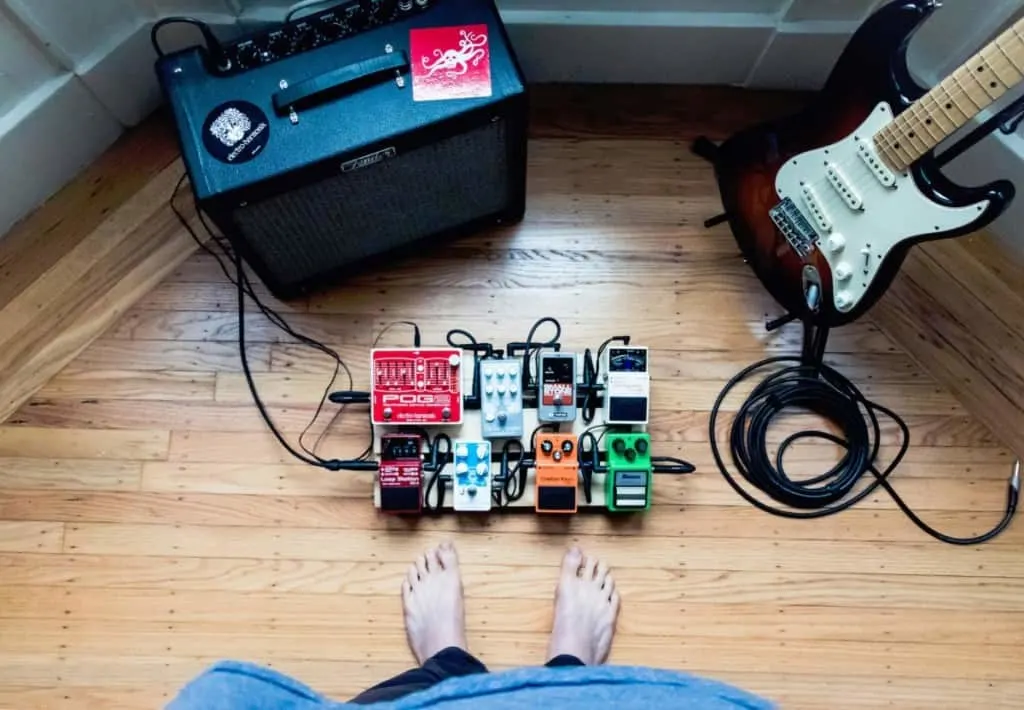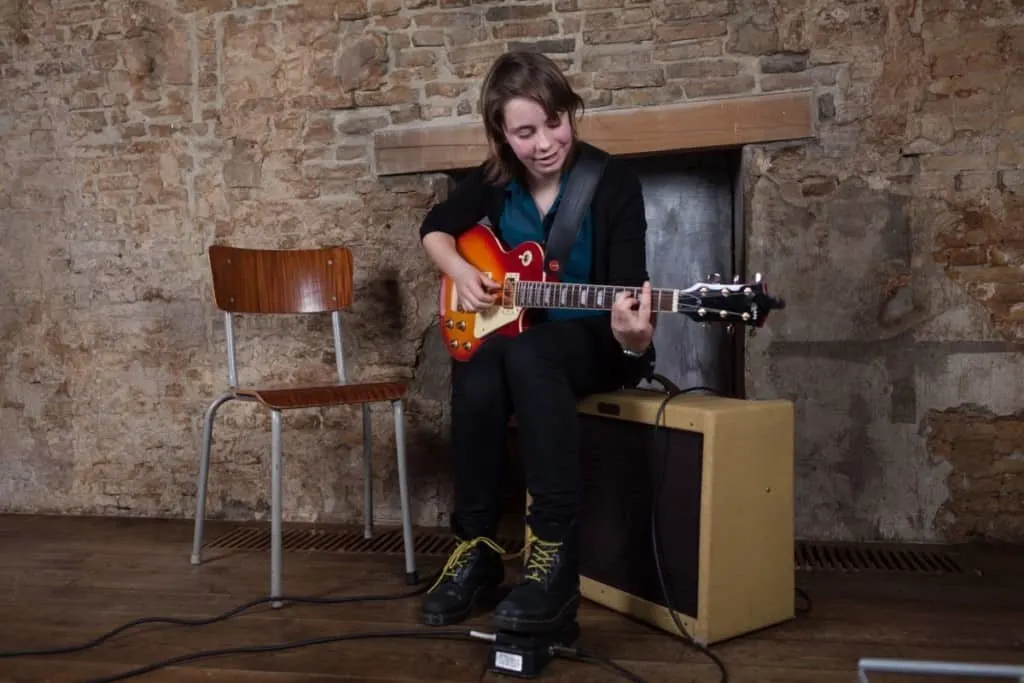Those of us who have been playing long enough to have owned many pieces of gear know just how fragile guitar pedals are.
So, can you leave guitar pedals plugged in?
Guitar pedals should not be left plugged in. You expose your pedals to electric current surges, possible heat issues, battery drain, humidity, and a lot of dust. This deteriorates your pedals little by little. If you want to preserve the life of your guitar pedals, then you should unplug them when not in use.
Guitar pedals are not only fragile but also super important when it comes to playing a live gig.
I mean, your signal chain is as strong as its weakest link and if a pedal fails in front of a lot of people, you shall be mad, to say the least. If you watch from minute 7:50 of this video you´ll see how even legends like John Mayer struggle with guitar pedals. (I set the video to start there)
Now, I am here to pour all my knowledge in the shape of this blog post and help you avoid mistakes that made me lose time and money. Are you ready to go to the bottom of the issue? Let’s do this.
Why You Shouldn’t Leave Guitar Pedals Plugged In
Leaving your guitar pedals plugged in can take you to several different scenarios.
These scenarios depend largely on what your gear is and where you live. There are weather conditions that are worse on some pedals than others. That being said, we are going to go one by one so you know what to do but most importantly, what to avoid, and why.
There is a massive range of guitar pedals available. For example, take a look at this huge selection on Amazon.
My personal favorite at the moment is the incredible Boss ME-80 Check this out here on Amazon.
Guitar Pedals And Battery Drain
Some pedals can run on a 9v adapter and some other, older pedals like my ´68 Vox Tone Bender need a battery to operate.
The thing about batteries and pedals is that the battery drain starts the very moment the tip of a plug goes all the way into your pedal. This means that if you have a battery-operated pedal, you should always unplug the input of it (the output doesn’t change a thing) otherwise when it’s time to use it, it will not work.
Now, a little word on batteries: they sound different as they drain.
Your pedal will sound drastically different with a full battery than with a half-full battery. It is not like with an AC adapter that goes 9 volts or 0 volts, you get this cool degrading tone with time that some guitar players really love.
Finally, it is important to switch to rechargeable batteries so you can take care of the environment and also have always a charged spare in case one dies on you because… oops! You forgot to unplug that pedal again!

Electrical Power Surges
In a perfect fantasy world, the current will be a steady 110v or 220v and will never change no matter what.
Well, in this world, the real one, electric current goes through surges and those can severely damage your equipment. If, for example, an AC adapter usually delivers 9 volts to your pedal with a power source of 110v, and that original power goes through a surge, it might deliver way more than 9v to your pedal result in a burnt unit.
Believe me, I’ve seen burnt pedals in my life (in fact, I burnt some myself accidentally, but shh) and it is not a nice view. This weird smell starts coming out of it is sad, to say the least.
The way to protect your pedals against electric power surges is to get a surge protector and always unplug them when you are not playing.
This is the surge protector I currently use in my studio. Tripp-Lite
Heat And Guitar Pedals (When Left Plugged In)
This is quite a delicate matter to discuss.
Not all guitar pedals consume the same amount of electricity and not all of them actually heat up. Chances are if you leave your guitar pedals connected for a long period of time, they will eventually heat up. This is no big deal for some units, but some of the components in older pedals tend to wear out with time.
By leaving them on, you are making that happen sooner rather than later.
To avoid this from happening always disconnect every pedal from power after playing. This way you’ll maximize your pedals useful life and won’t go through stage noises and problems like our friend John Mayer in the video above!
Guitar Pedal Maintenance
Right from the last item and cascading to the next, we have maintenance.
Pieces of gear like guitar pedals do need maintenance. They are sturdy, well-built, and manufactured to be at our feet and be stomp on. Well, although they are tough, they need maintenance as well as your guitars, amps, and any other gear.
To lower the maintenance rate of your pedals what you can do is to protect them as much as you can. If you are a touring musician, you very likely have a pedalboard which is surfaced with Velcro to which you can attach your pedals and take them from one place to the next perfectly tidy and just plug and play.
For instance, pro musicians like Radiohead’s Ed O´Brien have their pedalboard put together by professionals.
Take a look at this video to see how it’s done.
If they are not like that, safe and sound, plugged next to all their friends and ready to go, they should be in the box they came in with all the packaging. Remember, the more you take care of them, the less maintenance they will require.
Guitar Pedal Dust & Moisture
Speaking of maintenance, a clear sign of a pedal that has not received a lot of love recently can very well be the fact that it has dust and moisture signs.
- Dust – For some pedals like Cry Baby wahs (or any of its kind with the rotating potentiometer) and those that have knobs suffer a lot from dust. You can hear a crackling noise when turning the knob or rocking the pedal. Also, if that dust is not cleaned and mixes with grease or oil, it can be damaging for the pedal beyond the noise. Once a knob gets stuck, you are in trouble and might even have to replace it. Your pedal will never sound or be worth the same after that.
- Moisture – This is even trickier and more dangerous. Moisture can come from many different sources. The most dangerous one for pedals is always humidity. This phenomenon is another way to name the water percentage in the air. High humidity can be great for the environment, but it is not something you want for your pedals; it can damage the circuits and eventually even burn the board. If you happen to live in a place where high humidity is common, you have to be extra careful. Finally, if you ever come across a pedal with the paint chipped off and a wobbly, swollen case, pass on it because that was moisture doing its thing.
How To Maintain Your Guitar Pedals
Ok, so we’ve been through what you shouldn’t do and why, but which is the correct way to do it? The correct way to do it is following these pro tips:
· Keep your pedalboard well-maintained, dust-free, and moisture-free using either a soft or a hard case to keep it there as much time as possible.
· Make sure you don’t leave any adapters plugged into 220v or 110v during the times you are not playing.
· Clean your pedals with a brush and look for signs of moisture building up so you can take early action and save the unit.
· Always bring spare batteries and mark the pedals you need to unplug to avoid battery drain with tape so you will remember to do it consistently.

What About Leaving Guitars And Amps Plugged In?
Guitar pedals aren’t the only thing you can leave plugged in, what about guitars and amplifiers?
Well, the same principles apply to them as well. In the case of amplifiers, there are several other risks like for example someone not realizing there is a cable on the floor and stepping on it bringing that amazing valve head to the floor and making a mess.
Also, the current surges can be especially harmful to the circuitry, and waking up to a blown amp is one of the worst sights you will ever have.
In the case of guitars, we can divide them into two categories:
· Passive pickups – Most electric guitars in the world have passive pickups. Leaving your guitar plugged in can be as risky as with your amplifier and you might end up with a fallen guitar with a snapped headstock. Also, a power surge strong enough to go through the cord to the circuit can very well ruin your pickups. After all, they are magnets wrapped up in copper.
· Active pickups – Guitars like 99% of the acoustic electrics and some electrics loaded with active pickups (EMG, Lace Sensor) need a 9-volt battery to operate. They follow the same principle as effects units running on battery and start draining it as soon as the tip of the plug goes all the way in. Thus, if you leave it plugged in when you are ready to actually play it, it won’t work because of battery drainage.
Take a look at my article 21 best accessories for guitar players. You can find it here.
Conclusion
There are a plethora of reasons why you shouldn’t leave guitar pedals plugged in. We covered them extensively in this article and although they might seem inexpensive and replaceable, a malfunctioning pedal in the middle of a show can truly be a headache.
Follow these tips, protect your gear and enjoy years of playing through it; always remember that in audio every chain is as strong as its weakest link. You might not have an amazing pedalboard like Ed O´Brien´s just yet, but taking good care of the pedals you have right now is the right path to get there.
Happy playing!
